Port revenues in Subic Freeport improved by 6 percent in 2017 driven by substantial increase in transshipment operations and higher calls by foreign ships as the government seeks to divert cargoes from the congested Manila ports.
Data from the Subic Bay Metropolitan Authority (SBMA) showed port revenues in 2017 reached P1.207 billion from P1.137 billion in 2016.
SBMA also registered there were a total of 2,778 ship calls in 2017 or 10.4 percent lower than the 3,069 ships that sailed in 2016. Of this total, foreign ship calls improved by 12 percent to 1526 from 1,365 while domestic ships declined by 27 percent to 1,252 from 1,704 in 2016.
Containerized cargo volume also went up by 13 percent to 140,938 TEUs (twenty-footer equivalent) from 124,707 TEUs the previous year. However, the non-containerized cargo volume decreased by 6 percent to 6,633,189 metric tons from 7,071,444 MT the previous year. Notably, transshipment registered a dramatic rise of 468 percent to 2,084 from only 368 in 2016.
SBMA also reported that their export trade value in 2017 also rose by 38 percent to $2.332 billion from $1.69 billion in 2016. Import trade value also rose by 11 percent to $1.771 billion from $1.601 in 2016.
SBMA is being developed as the country’s alternative seaport in Luzon to decongest the Manila port.
Already, the BCDA is implementing a cargo rail that will link the two freeports Subic and Clark. This 70-kilometer cargo railway will run parallel with the existing Subic Clark expressway has a project cost of R50 billion.
SBMA Senior Vice-President Joshua Bingcang said this 70-kilometer railway is part and parcel of the Luzon railway system of the government which connects from Ilocos to the western side of Tuguegarao and meet in Tarlac up to Bicol with branches in Clark and Batangas.
“This will decongest Manila by enhancing the viability of Subic and Batangas ports,” he said. In the future, the Subic-Clark railway will have a passenger service. Bingcang sees companies shifting to Subic instead of Manila ports because the cost of moving goods using a railway is just one half of the cost of using the regular truckers.
By Bernie Cahiles-Magkilat
Source: ship.mysubicbay.com.ph
